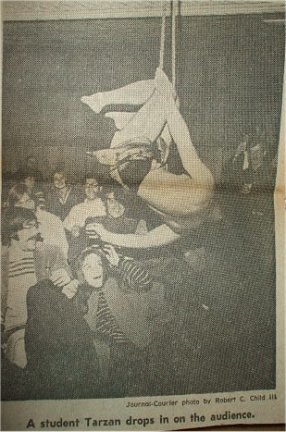
First and Only Weekly Online Fanzine Devoted to the Life and Works of Edgar Rice Burroughs Since 1996 ~ Over 15,000 Webpages and Webzines in Archive Volume 3659 |

First and Only Weekly Online Fanzine Devoted to the Life and Works of Edgar Rice Burroughs Since 1996 ~ Over 15,000 Webpages and Webzines in Archive Volume 3659 |
TARZAN THE CONTROVERSIAL
Militants Oust 'Tarzan' At Yale Film Festival
THE NEW HAVEN REGISTER
Monday, March 16, 1970
Protest By Censorship At YaleAcademic freedom and civil rights were blatantly violated by 20 Yale students who stepped in front of a movie projector to force a halt to the showing of an old "Tarzan" movie at the university. The imposition of will by physical disruption, amounted to a form of censorship that made it impossible to carry out the intellectual exploration for which institutions of higher education exist.
The students who stopped the film presentation had no right to presume that the audience approved of any racist attitudes depicted in the story. Nor did it contribute to racial harmony and understanding to deny students an opportunity to witness expressions and attitudes which are considered racist.
It might very well be that the movie, intentionally or otherwise, shows clearly "Col. Blimp attitudes" in Africa w which now are fading and for which we can be thankful.
Does anybody have the right to blot out history? Can we know if progress is being made when educated persons are denied the right to see how things were in the past? Are all source books on American history to be burned because they contain accounts of slavery and other forms of social injustice?
The students who halted "Tarzan, The Ape Man" could have made an important intellectual contribution and advanced brotherhood by arranging for a discussion of racist elements in the film after a showing. They could have explained their feelings, elicited reactions, delineated all the reasons for their objections. Analysis and communication, not disruption, were called for -- consistent with the academic way of life.
JOURNAL-COURIER
March 12, 1970
Militants Oust 'Tarzan' At Yale Film FestivalTarzan -- world famous "King of the Jungle" -- finally met his match.
The downfall of the once-invincible film hero came within a matter of minutes Wednesday night at a Yale Record-sponsored showing of "Tarzan the Apeman" in the Yale Law School Auditorium
About a dozen persons stopped the show by standing in front of the film projector until an audience of approximately 200 at the urging of Thomas Carney, head of the Record, departed.
Johnny Weissmuller, 66, the Olympic swimming star who became the most legendary of the jungle super heroes, was also in the audience and was scheduled to give a talk. He left too, but not via treeways, and was being whisked back to New York late Wednesday by editors of the Record.
Some members of the apparently all-student and apparently all-black group were described as members of Yale's Black Student Alliance. The screen Tarzan is considered by some as racist and emblematic of attitudes of "white supremacy."
One member of the audience at one point jokingly called up on Tarzan to take action and oust the small group which had virtually taken over a part of the balcony.
Some students at the affair were barved in Tarzan costumes and one of them had earlier staged a Tarzan-like swoop. . . [See TARZAN, Page 17]
Claptrap Classics

TIME MAGAZINE EXCERPTS
TIME Magazine ~ February 6, 2011A curious thing happened to Edgar Rice Burroughs on the way to oblivion. When the 74-year-old novelist died in 1950, most of his 24 Tarzan books and ten Martian sagas were long out of print and far out of vogue. Then in 1961, a lady librarian in California removed a Tarzan book from the shelf on the grounds that the Ape Man and Jane were living in sin. Actually, as Burroughs went out of his way to establish in The Return of Tarzan, the two were properly married in the bush by Jane's father, an ordained minister. But the nationwide newspaper publicity over Tarzan prompted paperback publishers to burrow into the Burroughs estate.
Genteel Voyeur. As it turned out, at least eight Tarzan titles and a galaxy of Marses (Burroughs habitually produced one of each yearly) were in the public domain—and what the public wanted. Tarzan and Mars books now sell more than 10 million copies a year, account for one-thirtieth of all U.S. paperback sales. Latest to be reissued: A Princess of Mars (1917) and A Fighting Man of Mars (1931).
Their author, as the Martian duo (Dover; $1.75) makes clear, was as much of a threat to public morality as a parlor aspidistra, which his prose style often resembles. A Burroughs hero is virile and all that, but he is first and last a gentleman, inclined more to genteel voyeurism than simian action. "She was as destitute of clothes as the Green Martians who accompanied her," observes John Carter in A Princess of Mars. "Indeed, save for her highly wrought ornaments, she was entirely naked, nor could any apparel have enhanced the beauty of her perfect and symmetrical figure." Clean living was the ticket. In The Fighting Man of Mars, Burroughs relates, "Tul Axtar reached for his pistol and I for mine, but I have led a cleaner life than Tul Axtar had. My mind and muscles coordinate with greater celerity than those of one who has wasted his fiber in dissipation. Point blank I fired at his putrid heart. . ."
Anti-Intellectual Snob. For a man who flunked out of Andover and flopped at half a dozen business ventures before he turned to writing at 37, Burroughs found time to acquire a comprehensive set of prejudices. An anti-intellectual and a snob, he disapproved of any race but the white (the Red Martians are morally superior to the Green Martians because they have remote white ancestors) . He was suspicious of most white men as well, save for "natural aristocrats"—among whom are included "John Carter, gentleman of Virginia," the hero of the Mars stories and, of course, Tarzan, who is really an English lord. The Continent was plain depraved. "A splendid young woman I had known in New York," says one Burroughs hero, "had been head over heels in love with a chum of mine—a clean, manly chap—but she married a broken-down, disreputable old debauchee because he was a count in some dinky little European principality that was not even accorded a distinctive color by Rand McNally."
Why 10 million paperback readers a year should beat a path to this convoluted claptrap is anyone's guess. Perhaps, suggests Psychiatrist Frederic Wertham, Burroughs appeals to a reader's "primitive instincts." A more likely explanation is that the books induce the same kind of "dreamless and refreshing sleep" that overtakes John Carter when he breathes the atmosphere of Mars.
Tarzanism vs. Marxism
TIME Magazine ~ April 28, 1924They read it here, they read it there, those Bolshies read it everywhere. "It" is Tarzan. Six books* of Tarzan adventures, in cheap paper editions costing 60¢, have been printed to the number of 250,000. "Yet," said a Moscow publisher, "the supply is far inferior to the demand. We could easily sell a million." A Moscow journal said: "We publish books and pamphlets about Marxism and our great revolution. We encourage young authors to interpret its spirit and inspire the masses.
We even issue cheap editions of the Russian classics. But the public reads—what? —Tarzan." Explaining why O. Henry, H. G. Wells, Conan Doyle, Jack London and Upton Sinclair are more popular than Russian authors, the newspaper continued: "It is because old Russian literature is out of date, and the new is dry, dull or too subtle for mass com-prehension."
The President of the Russian Poets' "Soviet," one Axionov, "the most sophisticated Russian litterateur," said that the Tarzan vogue was due to "the love of fairy tales instinctive in primitive peoples in general and Russians in particular. "Our revolution killed the fairies, just as education killed them in Western countries.
But if you dress up Jack the Giant Killer in a sufficiently modern guise to give him at least a semblance of probability, the masses will love him as did their fathers and grandfathers.
And to the fact that Tarzan takes his readers away from strenuous complicated modern life can be attributed the secret of his success. "In my opinion this alone proves the necessity for some dictatorship over the proletariat. On the other hand it appears that Tarzan is also extremely popular in America—but comparisons are odious." Walter Duranty, The New York Times correspondent, explained the epidemic of Tarzanitis by stating that"the newly emancipated Russian nation represents the average cultural level of the American schoolboy between 11 and 16.";
*Written by Edgar Rice Burroughs. Published by Grosset and Dunlap.
Cheetah, Alleged Primate Actor from 'Tarzan' Films, Dies Hollywood Reporter ~ December 28, 2011The chimpanzee, who was reportedly 80 at his time of death, is said to have appeared in the early 1930s installments of the famous franchise.
One of the most famous animal actors in Hollywood history is gone.
Cheetah, said to be the chimpanzee sidekick from Tarzan films, died of kidney failure over the weekend at the Suncoast Primate Sanctuary in Palm Harbor, Florida. The Tampa Tribune reports that he was roughly 80 years old.
Hardly the only primate to take on the iconic role, Cheetah probably received the most exposure. He appeared in the 1932-1934 installments of the franchise, at the beginning of its heyday when Olympic swimmer Johnny Weissmuller took over the title role.
In addition to having the distinction of being famous, Cheetah's longevity was one of his greatest accomplishments. Suncoast outreach director Debbie Cobb noted that chimpanzees generally live between 35 to 45 years in captivity, and only 25 to 35 years in the wild.
She also spoke highly of his character.
"He was very compassionate," Cobb told the Tampa Tribune. "He could tell if I was having a good day or a bad day. He was always trying to get me to laugh if he thought I was having a bad day. He was very in tune to human feelings."
Cheetah moved to the sanctuary around 1960, where he remained the most famous of its primate residents until his death. His interests included finger-painting, watching football and nondenominational Christian music.
Among Cheetah's Tarzan features were Tarzan and His Mate and Tarzan the Ape Man, where he starred alongside Weissmuller and Maureen O'Sullivan, who played "Jane."
O’Sullivan’s daughter, actress Mia Farrow, reacted to Cheetah's passing on her Twitter account, painting a less flattering portrait than Cobb.
"My mom, Tarzan's Jane, referred to Cheetah-the-chimp as 'that bastard,'" she wrote, "saying he bit her at every opportunity."
Hollywood Reporter ~ December 28, 2011 'Cheetah' Death Reignites Lingering Debate
Over Identity of 'Tarzan' Chimpanzees
Experts call it "improbable" that a chimpanzee live to 80, making this the second Tarzan primate suspected of being a fake.Like Rin Tin Tin, Lassie and most famous animal characters, Cheeta (or "Cheetah") was not played by one single chimpanzee.
The role of Tarzan's primate sidekick was assumed by over a dozen different chimps over the course of the film franchise's history. But unlike animal actors of other species, the history of this one ape has been loosely documented at best.
One chimp said to play Cheetah in the early 1930s died at a Florida sanctuary on Saturday. After the initial story from The Tampa Tribune, which featured an interview with a caretaker, contradictory reports are emerging saying that 80 is unrealistically old for a chimpanzee -- famous or otherwise.
The New York Times cites Dr. Steve Ross, the assistant director at Chicago's Lester E. Fisher Center for the Study and Conservation of Apes.
“To live into your 70s is really pushing the limits of chimp biology," said Ross. "Eighty is tough to swallow.”
He concluded that it's "very improbable" that a chimpanzee who acted in 1932 would still be alive in 2011, adding that the oldest documented age of any living chimpanzee is just 70. And that's a female. The male, Keo at Chicago's Lincoln Park Zoo, is only approaching 53.
Ross says the difficult-to-track nature of acting chimps has made it hard to study how their unusual circumstances may have affected their lifespans.
“I’ve spent a couple years now trying to track down some of these chimps,” he said, “and it more often than not leads to a dead end.”
This Cheetah is not first of the Tarzan chimps to raise eyebrows. In 2008, a purportedly 75-year-old retired "Cheeta" living in Palm Springs was proven to be a fake. The bizarre, fictional ordeal of his journey from Liberia to Hollywood in 1932, was used to debunk his identity. It was also fodder for the 2009 mock-autobiography, Me Cheeta.
British writer James Lever, who wrote the book lampooning the Cheeta myth, sounded off on the death of this latest ape to The Guardian.
"Nobody seems to know very much (or even anything at all) about the chimps who played Cheeta," he said. "I rather think he'll be dying a lot over the next few years."
The most-documented Cheeta was named Jiggs. He originated the role in the 1932 film Tarzan the Ape Man, before dying from pneumonia in 1932.
Johnny Weissmuller fan, Bob Owen, was at the Yale disruption described above.
Read his account in ERBzine 5399
How I Met Johnny Weissmuller
By Robert Owen
www.erbzine.com/mag53/5399.html

JIGGS' SCRAPBOOK
(Cheetah ~ Cheeta ~ Cheta ~ Nkima)
Photos culled from his many appearances in our ERBzine.
ERBzine 1697See our full coverage ot
TARZAN THE APE MAN (1932)Part of our
ERBzine Silver Screen Series
www.erbzine.com/mag5/0502.html
